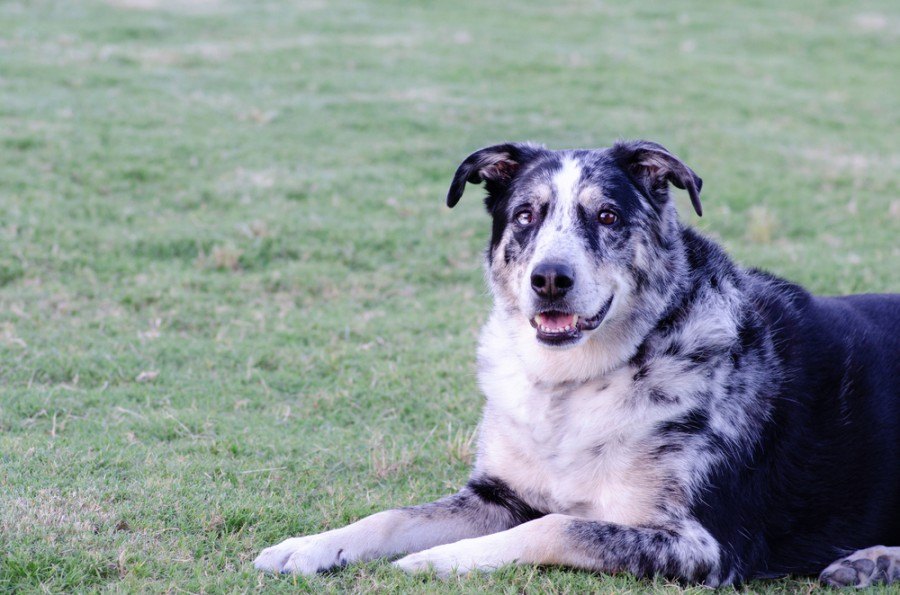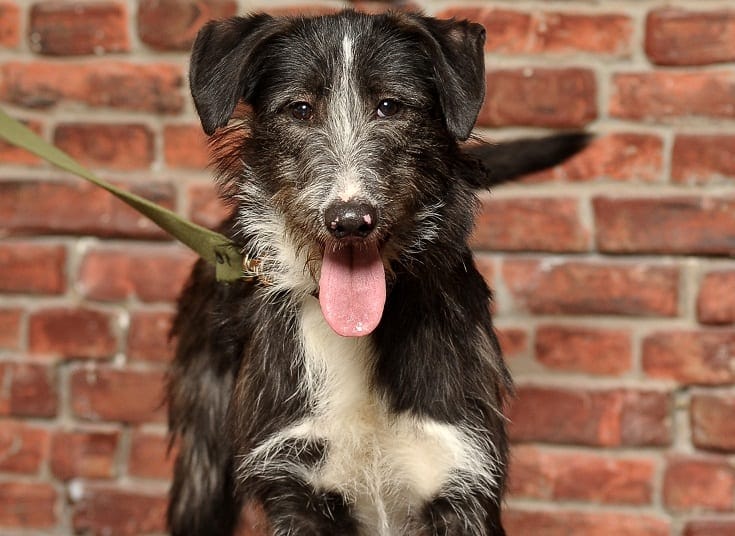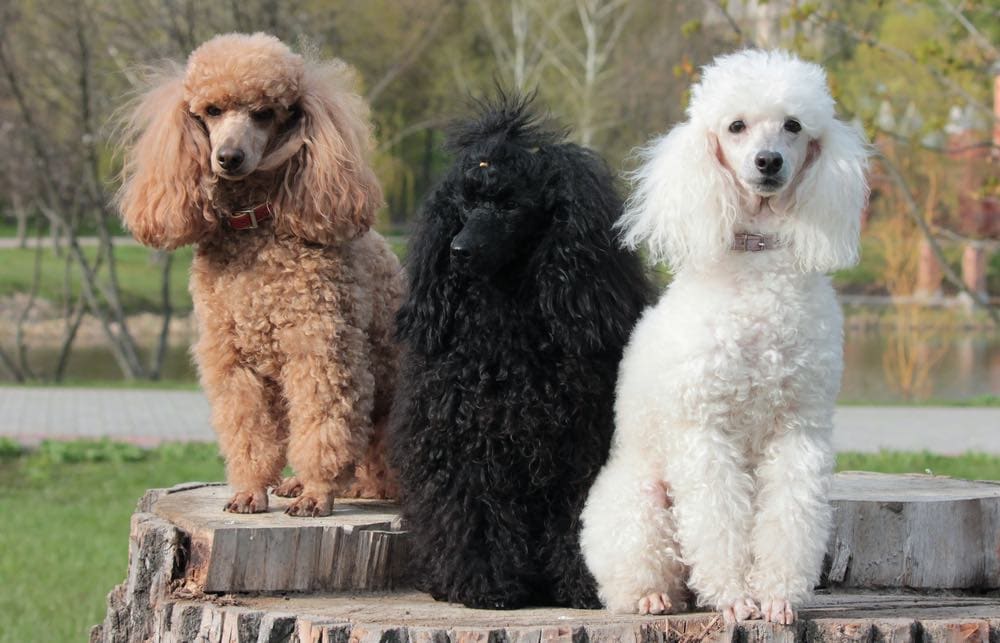Labraheeler (Labrador Retriever & Blue Heeler Mix): Info, Pictures, Characteristics & Facts

Updated on
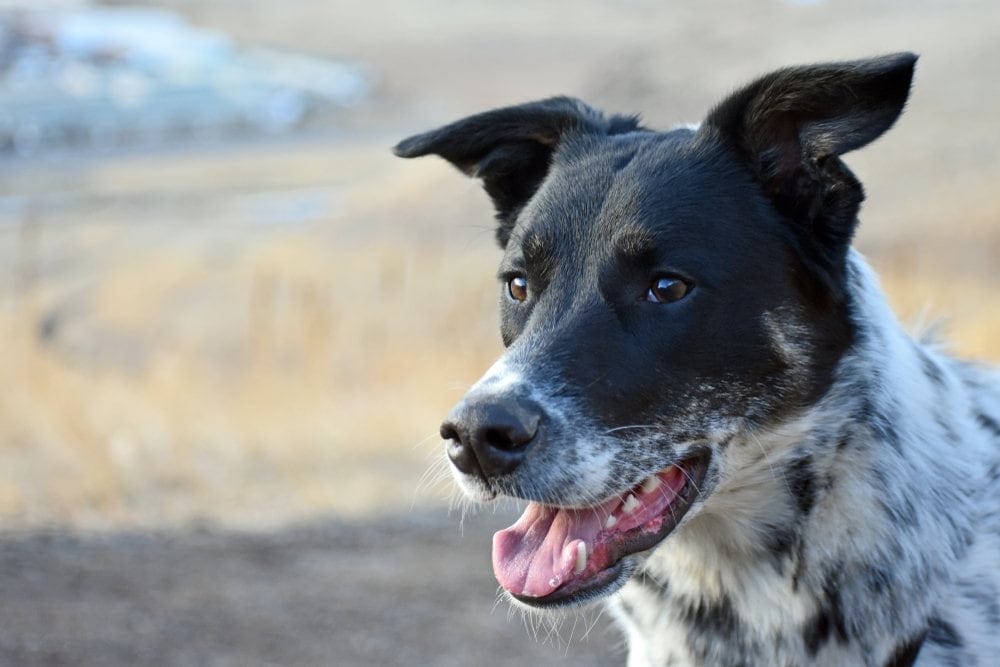
Height:
41 – 65 inches
Weight:
18 – 25 pounds
Lifespan:
12 – 16 years
Colors:
Black, blue, red, white, cream, brindle, brown
Suitable for:
Active families with or without children, rural settings or large yards, a single person who is very active and home often
Temperament:
Friendly, intelligent, highly active, sweet, affectionate
If you are a very active individual who is looking for a pup to join your energetic lifestyle, the Labraheeler may be the right breed for you. This designer breed is a mix between a Labrador Retriever and an Australian Cattle Dog, also known as the Heeler. They are very sweet, affectionate, and loyal. They make a great addition to any family, yet they require a lot of your time and energy.
Even if the Blue Heeler Lab mix sounds like a great fit for you so far, it’s not yet time to ask how much is that doggie in the window. First, you have to understand all of the different aspects of this breed so you can make the right decision for you, your family, and your potential new pet.
To help you with that decision, we have provided a detailed description of the Labraheeler below. We will share all the info you need on their temperament, care, puppy life, and much more. By the end, you will be equipped with all of the info you need to make the best decision possible.
Labraheeler Puppies
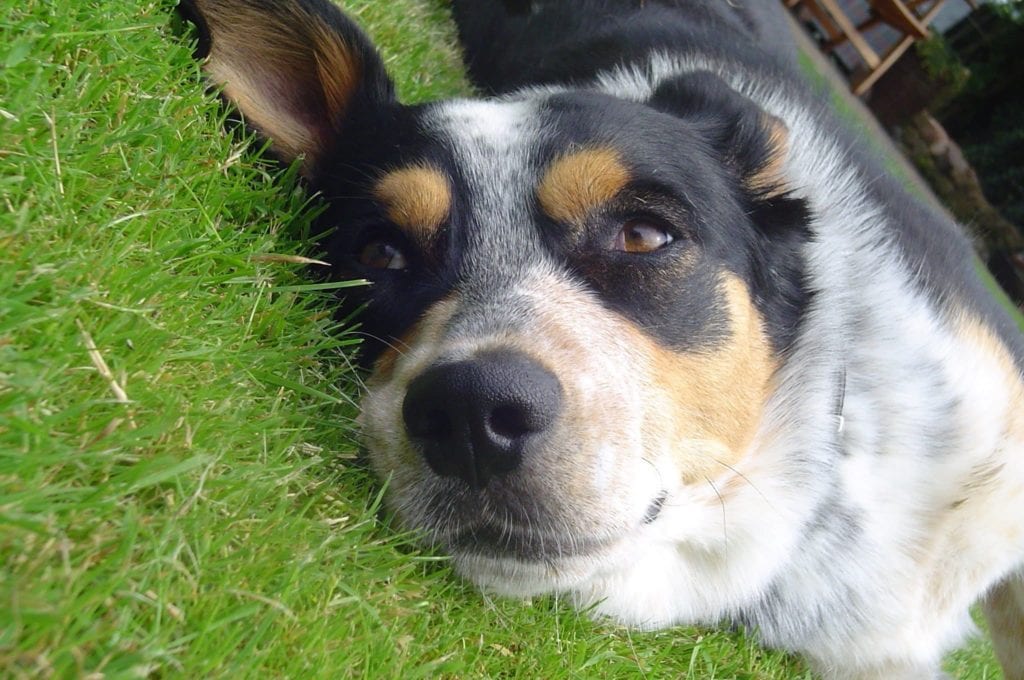
If you have come across a Labraheeler puppy, you know how adorable they can be. This designer hybrid breed comes from one Labrador Retriever parent and one Australian Cattle Dog parent. Together, these two purebreds create a puppy that is sweet, affectionate, super-active, and adorable.
Even at such a young age, a Blue Heeler Lab mix puppy will require a lot of your time and energy. Not only is it important that they are trained and socialized right away, but they are more active than most and will require a lot of your time and energy outside. What’s more, this is a breed that does well in working environments whether training or performing tasks.
To give you a little more background, the Labrador Retriever has been in existence since the 17th century. They originated from Canada where they were used as hunting, hurting, and retrieving animals. During the 1800s, the breed was brought to the UK where they gained a lot of popularity. Today, they are the most popular family dog in the United States.
On the flip side of the coin, the Australian Cattle Dog originated during the 1800s in its namesake country. This dog has enjoyed many different positions over the years; however, they were originally bred to assist ranchers with their herds. They were particularly apt at this job as they would nip at the heels of the cattle but would not bark and scare them into a stampede.
The offspring of these two purebreds gained the best traits of both. Not only is the Blue Heeler Lab mix a loyal and family-oriented dog, but they are ready to get down and dirty outside and frolic in the mud.
3 Little-Known Facts About the Labraheeler
1. Net Pulling
One of the first responsibilities of the Labrador was to assist fishermen by pulling their fishnets into the shore. Like a long game of tug-of-war, the dog drags one end and pulls the net full of fish onto the bank.
2. Part Dingo
The Labraheeler is also part Dingo. The Australian Cattle Dog was originally created by crossbreeding a Dingo with a Smithfield dog. The Dingo was then bred with a few other breeds to perfect what is now known as the Australian Cattle Dog. The Dingo ancestry still rings true even into this designer breed.
3. Webbed Feet
As an avid swimmer, the Labraheeler has webbed feet. This is something that has been passed down to them from their ancestors and allows them to be very comfortable in aquatic situations. If you are a beach person yourself, this pooch will fit right into your lifestyle.
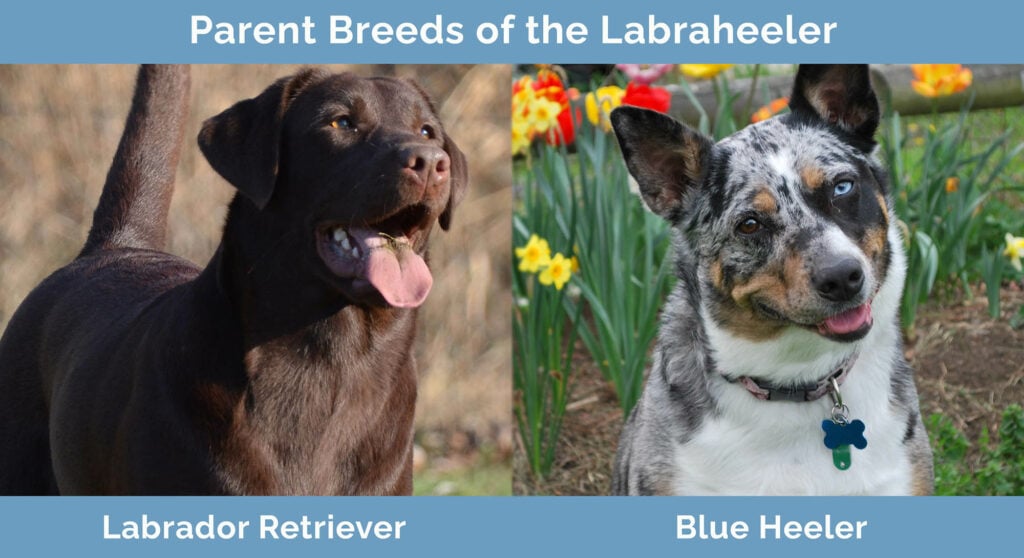
Temperament & Intelligence of the Labraheeler 🧠
As mentioned, the Labraheeler has gained the best traits of both parents. This is a sweet, affectionate, and loyal dog that is very family-centric. They are active, curious, and even make great guard dogs. This breed also has very high intelligence and has been engaged in many different careers such as police work, agility training, hunting, guarding, search and rescue, and tracking. This is outside of the normal herding, retrieving, and fishnet pulling activities.
Due to their high intelligence and high activity level, the Blue Heeler Lab mix is at home in rural settings with either very large yards or fields to run around in. They spend a good portion of their day active, yet they benefit from mental activities, as well. Whether it is swimming, rolling around in the dirt, or jogging by your side, this pup is at its happiest when in movement.
The Labraheeler is also a great guard dog. They can be cautious around new people, and it can take a bit of time for them to warm to newcomers. Once they do, however, they are a very friendly and social breed. That being said, this pooch tends to become stubborn as they age. This is one reason why training them as a small puppy is extremely important.
It’s also important to note that the Blue Heeler Lab mix does not do well with a lot of alone time. They prefer to be around the hubbub of the family or even with one person as a companion. When left alone, they can resort to destructive behavior such as chewing, barking, and sometimes digging.
Are These Dogs Good for Families? 🏡
As you may have noticed, one of the strongest traits of the Labraheeler is their loyalty to their family. Not only do they become attached to the entire family as a unit, but they are also great with kids and seniors. That being said, the puppy must be brought up around smaller children or at the very least socialized well.
Labraheelers tend to bite if they are handled roughly or mistreated. Due to this, accidents can happen when small children are too rough. It is important that you teach your kids how to properly engage with the dog, as well as, teaching the dog how to socialize with smaller children.
Other than that, the Blue Heeler Lab mix thrives on large families with a lot of activity. As this dog is more likely to wear you out than the other way around, they do very well in homes where there are multiple active people to keep them engaged for most of the day. Also as mentioned, they do not do well with a lot of alone time and will, at the very least, require some activity to keep them occupied when they are not able to be out running.
Does This Breed Get Along With Other Pets? 🐶 😽
Like most breeds, this can depend heavily on whether or not the dog was socialized at a young age. Labraheelers are well able to rub along with other dogs or other pets in general. Keep in mind, however, that they’re herding ancestors and hunting ancestors can still play a role in their current behavior.
Introducing your puppy to as many sites, sounds, smells, and faces as possible at a young age will help them interact with other animals. In general, the Labraheeler tends to be a bit wary of other dogs. Again, this can also depend heavily on the individual animal.
Things to Know When Owning a Labraheeler:
Now that we have gone over all the good stuff, it is time to take a look at their practical care. Even if you live on a farm with a large family and are active from dawn to dusk, there still may be aspects of this breed that do not fit in with your lifestyle. For that reason, we will provide you with some care guidelines for the Labraheeler below.
Food & Diet Requirements 🦴
One difficult aspect of designer hybrids is there is not a lot of documentation regarding the origins of the breed. This can provide some holes in issues such as dietary restrictions and food sensitivities that the breed may have. The current research shows that the Labraheeler does not have any dietary restrictions outside of the norm, however. Time may tell, though.
Keep in mind, they should be fed a nutritious and healthy diet that is recommended by your vet based on their age, weight, health, and activity level. Nonetheless, there are some basic dietary guidelines that you can follow for a highly active dog. For example, providing them with food that is high in lean protein is a good place to start. Protein is one of the most important aspects of any dog’s diet. It is what fuels their muscles and allows them to be active.
After protein, you want to look at fat and fiber. Unlike us, dogs benefit from healthy fats. They break them down and turn them into energy, which also fuels their active lifestyle. Fiber, on the other hand, is important for their gut health. Many experts believe that your pet’s overall health is determined by their gut’s overall condition, and you must provide them with meals that will support their digestive system.
After those nutrients are taken care of, there are other things you should look at like secondary ingredients such as grains, vegetables, vitamins, minerals, and supplements. All of these things combined will create a nutritious meal to keep your pet healthy. You also don’t want to forget about treats. It is perfectly healthy to provide your pet with treats and snacks throughout the day as long as they are low in sugars and other unhealthy ingredients.
Exercise 🐕
You may have picked up on the fact that the Blue Heeler Lab mix is one active canine. They are on the go for the majority of the day and spend little time lazing about. This breed does well with a wide range of activities, but it is important that they get at least two to three 30-minute walks per day. What’s more, they should also get a few outdoor playtimes. Whether that is chasing a frisbee, herding cattle, or pulling in fishnets, it should still be an activity that helps them release some of their energy.
Your Labraheeler will also benefit from mental exercises. Things like agility courses, tracking, and other games that will teach them tricks or commands are also very helpful. The Labraheeler tends to engage in destructive behavior when they have excess energy. In this case, excess energy builds up a lot quicker than it would in other breeds.
Be that as it may, life can get in the way of normal daily activities. This is why it is also a good idea to provide your pet with stationary toys such as chewing bones, puzzles, and other entertainment that can hold their interest.
Training 🦮
Training a Labraheeler is best done as early as possible in the four major areas. Socializing, obedience, housebreaking, and behavioral training should be started right away. This breed tends to get a bit stubborn as they get older, but if they are properly trained at a young age, their stubbornness will show in other ways that will not affect their safety or your frustration level.
Like most dogs, this pup responds well to positive reinforcement. They are eager to please and to be a part of the activity, so they will throw themselves into training with energy and enthusiasm. Persistence and consistency typically pay off along with a few well-deserved treats and rewards.
Just remember, dominance and anger are things that will have the opposite effect with this canine. They do not handle being mistreated very well, and they can lash back out.
Grooming ✂️
Grooming this designer breed is pretty basic. They have short to medium-length straight fur that is averagely thick. They also have moderate to heavy shedding depending on the season. It is recommended that you brush your pet with a pin brush weekly to get rid of any excess fur. This can be done more often during the heavy shedding season.
You should also keep an eye on your dog’s ears for infections and clean them out for any wax buildup or debris. Their teeth should also be cleaned a few times a week (if not daily) to keep their oral hygiene in check. Their nails should also be trimmed once a month or every 3 weeks depending on the need.
Bath time is also something that can be done based on need. It is important to note that this dog loves to swim and also enjoys a good romp in the dirt so bath time can vary. Some Labraheelers can have skin sensitivities, so it is important to use a gentle shampoo that is alcohol-free and will not irritate any sensitive spots.
Health and Conditions ❤️
Like any breed, the Labraheeler is more prone to certain illnesses than others. Of course, their lifestyle, diet, age, and genetics can all play a role in whether or not they will develop any of these issues. Take a look below at some of the serious and minor conditions that could develop.
- Elbow dysplasia
- Cataracts
- Skin rashes
- Sensitivities
- Patellar Luxation
- Progressive retinal atrophy
- Hip dysplasia
- Arthritis
Male vs. Female
There is a lot of debate regarding whether or not there is any difference between a male and a female dog, regardless of breed. Some experts argue that males and females are more predisposed to certain behaviors while others maintain that it is a nurture vs nature situation. The one thing most experts agree on, however, is that fixing your pet can make a significant difference in their temperament and personality.
Every dog is different and comes from a different genetic background. Their upbringing, care, diet, house, and early handling can all play a role. That being said, their hormonal cycles can make a difference in how they behave and react to certain situations. For example, a male Labraheeler might be more likely to run off if he catches the scent of a female and if he has not been neutered. The same goes for a female Labraheeler that has not been spayed being a bit more grouchy or irritable if she is feeling some discomfort. Overall, the difference may very well come down to the individual Labraheeler and their genetics.
Final Thoughts
If you live in a rural area with an active family who is always bustling about and you are looking for a sweet-natured, affectionate, and loyal family companion, the Labraheeler is a great breed for you to look into. Even variations of the above scenario would make a great fit for this designer breed. This canine is a gem to behold. Not only are they loving and sweet-natured, but they will add a certain chemistry to your family dynamic.
It is important to remember that any dog that you bring into your household will now be reliant on you for their health and happiness. This happy and energetic dog is a great fit for many households, yet they will require a lot of your time and attention. That being said, the Labraheeler can add just as much value to your home as you do to their life.
Featured Image Credit: Austin Hawley, Shutterstock


